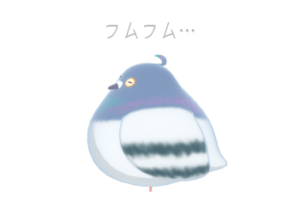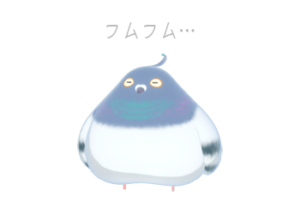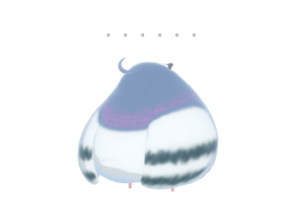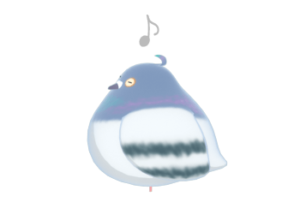
When I switched from the game company where worked for 6 years to a 3DCG production company, one thing led Toha to take daily notes on my 3DCG work.
After more than 5 years of daily notes on the work...
I found that "3DCG work records are quite useful information".
In this article, I will try to show you what exactly it is useful to keep track of your 3DCG work, with specific examples.
I'm writing this in the hope that it will be useful for practical things like jobs and career changes, so you might be interested please read it!
- Daily notes and records of 3DCG work...
- Recording 3DCG work helps create a work schedule
- Record of 3DCG work is helpful in the creation of a work history
- Record of 3DCG work is a testament to your days as a 3DCG artist
- Summary: I recommend keeping a record of your work, even if it's just a quick note
- Extra: The daily record keeping method that Toha does
Daily notes and records of 3DCG work...

What made me decide to write down the details of my 3DCG work every day was the "monthly report" I was required to write at the 3DCG production company at my new job.
What projects did they work on that month, and if they worked on more than one project, what was the percentage? Once a month, each artist would write a monthly report and submit it to us.
Before I changed jobs, when I was working for a game development company, there were no monthly reports.
I had to write a monthly report for the first time at my new job, but when I tried to write it, it was difficult to remember what kind of work I had done for a month. I had no idea of the ratio of work on multiple projects.
Human beings are easily forgetful creatures, so it is difficult to recall clearly what happened even a week ago.
I had a hard time remembering what I did for a month, and I had trouble writing my monthly report.
So, being a pain in the ass, I thought about how to write a monthly report easily and came to the conclusion that "write down what you did every day" that's how I came to this conclusion.
If you write down the work before you forget it, you don't have to work hard to remember it at the end of the month; you can just look at your work notes for the month and write a summary of what you did.
I started recording my 3DCG work for this reason, but when I tried it, I discovered that it is useful for many other purposes than writing a monthly report.
Recording 3DCG work helps create a work schedule

First, recording your 3DCG work will help you when you create your work schedule.
This was also something that did not happen very often when I was at a game company, but in subcontract work for 3DCG production, the production schedule is often firmly set on a "day-by-day" basis.
The number of days in the schedule depends on the type and content of the project. Whether it is a smartphone project or a PS4 project, whether it is just modeling and textures for character creation, or whether we will also do weights and other setups...
It varies from case to case, but "How many days should the schedule be?" is decided through discussions between the client and the contractor.
For example, if a client asks for a character model in 10 days, including setup, it may be impossible to produce a model of the required quality in that time frame.
In such cases, it is necessary to explain "based on evidence" and secure a schedule, for example, "It will take 5 days for modeling, 5 days for texturing, and 3 days for setup, so please give us 13 days.
What is needed here is "evidence".
Evidence
Facts that support the validity of an action, etc. Facts that support the validity of actions, etc.
The client-side pays the contractor-side to produce 3D models. Simply, the longer the production schedule, the more money they pay. We do not want the schedule to be unnecessarily long.
However, we don't just want a shorter schedule and a lower price.
If all you get is a bad 3D model, no matter how cheap it is, there is no point in going to the trouble of paying for a 3D modeling service. (This also depends on the project.)
So, both the client and the contractor need to have the necessary schedule based on proper evidence.
Proper evidence.
Without it, it is difficult to create an honest schedule.
A useful tool here is the "3DCG Work Record".
If you recording your previous 3DCG work, you can use the work records as a basis for creating a schedule.
- Understand for yourself which tasks require how much time

For example, let's say you had a job where you had to do one character from modeling to set-up, and while you were working on that job, you wrote down the 3DCG work every day.
If you look back at your notes after the job is completed, you will see that this is usually the case.
- How many days did it take to complete one character model?
- Modeling, UVs, textures, setup, how many days each took
- Which tasks were done faster than expected and which, conversely, took longer?
- Which tasks were revised more or less often later?
There are only facts in the content of the documentation of my 3DCG work.
When you check your records later, you can see which tasks you actually spent and how much time you spent on them.
The point is "actual time spent by me".
As with anything, not just 3DCG, the speed of work varies from person to person.
Also, different people have different strengths and weaknesses in different tasks.
It depends on the person: modeling takes time but texturing is quick, modeling and texturing are fast but setup takes time, and so on.
You don't need to worry now about how fast you are working compared to others.
The first important thing is to know how much time you need for which tasks.
If you do not know this, you cannot come up with your work schedule.
It is difficult to determine if you can do your work in the number of scheduled days provided unless you know how much time you need to work.
And then...The easiest way to see how much time you need for any given task is to actually do the work and see how long it took.
It takes a good amount of time to complete one model of a character. When I am working on a model, I am hard at work and the days go by quickly.
When I count the number of days it took to complete a model, I am often surprised to find that so many days have passed, and I often try to remember the details of the work done over the days, but I cannot.
People can't even clearly remember what they were doing a week ago, so it is only natural that it is difficult for them to recall the contents of 3DCG work that takes more than a week to complete.
But I think I can make a note of the work we did that day.
It is hard to remember later, so it is easier to make it a habit to write down a little every day.
- Compare with past productions to get the current schedule

So, for now, let's say I recorded every day the 3DCG work I did at work.
Then work records gradually accumulate.
For example, in the case of Toha, when I was working as a subcontractor to create character models, I accumulated work records of various character model productions.
If you're creating a new character model and you find yourself thinking, "Oh, this character model looks like that character model I created before..."
You can find out from the records how many days it took to make a similar character model before.
Or, you can know "This character model has more complicated hair and clothes than the previous one that took 10 days to make, which means I can't make it in 10 days.
In other words, you can get a schedule of what you are making now by comparing it with what you have made in the past.
To be clear, Toha is extremely poor at scheduling.
Perhaps it is because I worked on a rough schedule at the game development company where I used to work.
When I joined a 3DCG production company and saw the daily schedule, I thought to myself, I could never make such a precise schedule!
I had no idea how many days it would take me to make a single character model because I had never counted, so at first, I just thought about how to make it work within the schedule I was given.
However, as I wrote down my daily 3DCG work and accumulated records of character model production, I was able to refer to records and some extent judge whether my current schedule was reasonable.
If you feel that your current schedule is not sufficient, consult with your manager or supervisor as soon as possible. If you can explain the reason for the shortfall, an understanding supervisor will adjust the schedule.
The basis for judgment here is the "record of 3DCG work.
If there were no work records, we would have to rely on our memory and our own experience to make decisions.
If you are confident in your memory and experience, this may not be a problem, but even if you are not that confident, work records will allow you to make objective judgments based on past performance.
As I mentioned earlier, the schedule is also an area where money is involved and cannot be casually extended for random reasons. A reasonable basis is needed to adjust the schedule.
Of course, if you make a lot of 3DCG, your work speed may increase as you become more familiar and competent.
At that time, we can try to come up with a schedule based on past work records plus current capabilities.
- Supplemental -
At subcontracted 3DCG production companies, it is the managers, leaders, and other superiors who set schedules with clients. The 3DCG artists on site do not directly negotiate schedules with clients.
However, since the actual work is done by the 3DCG artists on site, the supervisor checks with each of the artists to see if their schedules are acceptable.
Each artist examines whether or not the schedule for his or her portion of the work is appropriate, and if there is a problem, he or she reports it to his or her supervisor. I imagine that the process is similar to other 3DCG production companies.
(*Sometimes, depending on the situation, the schedule is so rigid that there is no room for adjustment.)
Record of 3DCG work is helpful in the creation of a work history

Now that we have talked about the usefulness of work records in creating schedules, there is one more useful thing.
Record 3DCG work on the job will help when creating your work history.
A work history is a document that is required when you change jobs and is not associated with you if you do not change jobs.
If you have no intention or plan to change jobs, don't worry about it.
But, well, you never know what life has in store for you. Even if you are not interested in changing jobs now, you may want to in a few years.
I think it's a good idea to look a little further down the road now for such a someday - I'm sure you'll be able to find it.
- what should be in your work history is in your work record

When a 3DCG artist changes jobs to another company, he/she usually write something like this in his/her resume.
- Summary, size, and duration of projects and projects in which you have worked
- The projects you worked on and the work you were responsible for within the project
- Actual production results (how many character models, how many types of motion, etc.)
- Software used in the job, available tools
What you want to convey in your resume is something like, "I have done this kind of work at the companies I have worked for, and I have this kind of work experience.
Therefore, I will write an easy-to-understand summary of the projects I was involved in at my previous job and the work I was responsible for. (*If the project is still under development or is contractually unspoken about, it is also necessary to write with consideration.)
However.
I said that even my monthly report, which summarized my work for the past month, was difficult to write because I could not remember what I had done when I tried to write it.
The work you write in your resume will go back several years, not just a month. You will never be able to recall it easily.
Particularly confusing are "duration" and "production performance".
For example, if you are working in game development, rarely, you cannot remember what kind of games you were developing, but the "duration" in which you were involved in the work can be quite confusing.
Moreover, if the "duration" is several years long, it becomes difficult to properly recall the "production results" of the work created during the period.
When Toha created a resume for my job change, I really had a hard time remembering these things.
I didn't start keeping records of my 3DCG work until after I changed jobs, so I didn't have a record of my work at that time. In the end, I couldn't remember much about it, and I ended up writing some of it down randomly so that it would make sense.
Since these documents are required for employment, if you write something uncertain, you will feel somewhat guilty... You want to write the correct information as much as possible.
Therefore.
If I had kept a record of my 3DCG work from the beginning, I could have easily created a resume. I thought about it later.
If it is just for your work history, you do not need to write down your work every day. It would be sufficient to simply note the duration, scale, and production achievements of the projects you were involved in when they started/finished.
But, well, if you only do something once in a while, you may forget to do it itself.
I think it would be better to make it a habit to do it every day, or on weekends, or at the beginning of the month so that you don't forget to keep doing it.
Keeping track of my 3DCG work in this way is another nice bonus.
Record of 3DCG work is a testament to your days as a 3DCG artist

The nice thing about the extra is that you can see for yourself what you have done.
When you continue to work as a 3DCG artist, you may find yourself saying, "I just realized that a year has passed. When you are busy doing whatever it is that you do every day, the days go by in the blink of an eye!
That's not a bad thing, but at the same time, it makes me wonder if a year has already passed.
Sometimes I wonder, "What have I been doing for the past year?"
I was not skipping work or anything.
You were busy, so you must have been working hard to get the job done that was in front of you.
However, it is surprisingly difficult to remember what exactly I did and what I got out of it.
I've already said this many times in this article, but people forget so easily.
Of course, there are times when the results of my work become visible, such as when a game I was involved in developing goes on sale or a 3D model I created is unveiled in a PV.
But there are times when a game you have developed goes into storage without ever being released to the world. Sometimes the 3D models we create are ultimately not used.
Besides, in today's game development, the development period often spans several years. Then, it would be like the achievements of one's work would not see the light of day or be unspoken for a long time.
At such times, you may suddenly wonder, "What have I been doing?"
But.
It is never the case that nothing was done.
This is supported by the "3DCG Work Record".
Well, from a big picture perspective, you may not be doing much. But from a smaller perspective, you are solving some problem or learning something new that you didn't know about every day.
Looking back at past work records, you can notice such small achievements yourself.
When I think to myself, "Wow, I've actually done quite a lot," I feel a little more confident as a 3DCG artist.
I believe that what I have actually done with my hands will not betray me.
The accumulation of these actions,
I believe will lead to growth and confidence as a 3DCG artist.
In another article, I wrote that If I can grow one more thing today than I did yesterday, It's OK!, The daily work record is truly a record of your daily growth as well.
Summary: I recommend keeping a record of your work, even if it's just a quick note

In this article...
I wrote about how keeping a record of daily 3DCG work can be useful in many ways later.
In summary, a record of 3DCG work can be useful like this.
- Helpful for scheduling in 3DCG production work.
- Helping you create a resume when you change jobs.
- It's a testament to the days I've worked as a 3DCG artist.
You may feel that it is a hassle to write down the details of your work every day.
Well, yes, it is slightly annoying.
In such cases, it may be a good idea to make a simple memo that is not too much of a hassle. In fact, the daily memo that Toha has been keeping is not detailed at all.
I feel that even a simple note like that is much more useful than leaving nothing behind.
If you read this article and think that you would like to try writing something down every day, please try it simply and easily so that you can keep up with it for as long as possible.
It will only make sense if you keep at it, so if you're going to try it, I'd encourage you to keep at it for a long time!
Extra: The daily record keeping method that Toha does

In fact, what Toha does...
write down the day's work schedule the day before tomorrow.
The idea is to write down the work to be done tomorrow in a memo, and when tomorrow comes and the day is over, what was a planned memo will become a rough record of the day's work.
Since it is only a schedule, there are times when work cannot be done as written. In such cases, I write the same schedule for the next day, so I can tell from the contents of the memo that the work could not be done as planned.
I use a word book for notes on my schedule.
It is a very ordinary vocabulary book like this.
When looking at it as a schedule memo, I prefer paper flaps, so a word book that can be removed and attached is just fine. On this one page, I write the day's date and scheduled work. It is a small piece of paper, so there is not much to write.
I started writing daily memos for Toha in 2014 as a monthly reporting measure, and as of 2020, I am on my sixth wordbook.
Even now that I quit the company and become a sole proprietor, I continue to do so every day.

Habit is a terrible thing.





List of comments